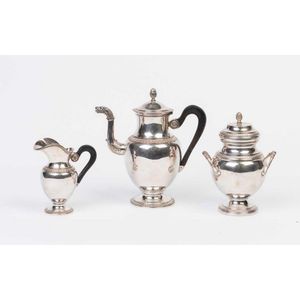Georgian Sterling Silver Teapot, Jug, and Sugar Bowl Set
You must be a subscriber, and be logged in to view price and dealer details.
Subscribe Now to view actual auction price for this item
When you subscribe, you have the option of setting the currency in which to display prices to $Au, $US, $NZ or Stg.
- Engraving - The method of decorating or creating inscriptions on silver and other metal objects by marking the surface with a sharp instrument such as a diamond point or rotating cutting wheel.
- Georgian - As an English stylistic period, Georgian is usually taken to cover the period from George I (1714) to the Regency of Prince George (1811-20), although the period from 1800 to 1830 is sometimes designated as the Regency period. During the Georgian period the great English cabinetmakers and designers such as Chippendale, Hepplewhite, Adam Sheraton etc., were all active.
Therefore there isn't a single 'Georgian style' as such and to say something is 'Georgian', usually means it was made between 1714 and 1830. This assumes we discount George V and George VI, both being from the 20th century.
The styles popular at the time of each reign were:
George I (1714-1727) saw out the last years of the Baroque period.
George II (1727-1760) reigned during the Rococo period.
George III (1760-1820) saw the last gasp of the Rococo, all of the early Neo-Classic 'Adam style' and most of the later neo-Classic 'Regency style'.
George IV (Prince Regent 1820-1830)encompassed the last of the 'Regency' style.
William IV's reign (1830-1837) was something of a no man's land (stylistically) and he wasn't a 'George' anyway. He covered the last glimmerings of 'Regency' and the start of the 'Victorian' style. - Sterling Silver - Sterling silver is a mixture of 92.5% pure silver and 7.5% of another metal, usually copper. Fine silver is 99.9% pure silver, and is relatively soft and the addition of the very small amount of copper gives the metal enough strength and hardness to be worked into jewellery, decorative and household objects.
This item has been included into following indexes:
Visually similar items

A three piece sterling silver tea service, 1910 Birmingham, with maker's marks for J Gloster Ltd, comprising a teapot, sugar bowl and creamer, of neoclassical styling each with gadroon decoration to the lower body and bracket handles, the teapot with an eb

A silver plated three-piece tea service, French, circa 1900

A German sterling silver fluted teapot and hot water pot by Wilhelm Binder, Schwäbisch Gmünd, circa 1900, the teapot 27 cm long, 770 grams total weight

Victorian Scottish sterling silver three piece tea service, mark of James McKay, Edinburgh, 1844, comprising cream jug, sugar bowl and tea pot, all with leaf capped handles, on four feet ornate with shells and scrolls, hallmarked (3), weight 1398 grams
